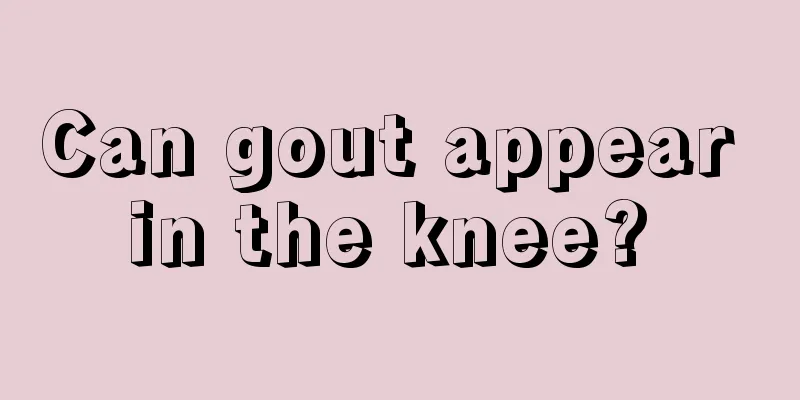Can gout appear in the knee?

|
Many people believe that gout symptoms only appear in the finger joints and toe joints. In fact, this is not the case. The knees will also show corresponding symptoms. Pain in the knee may also be related to gout. In fact, whether the body has gout cannot be judged solely based on the location of the pain. It is necessary to check the uric acid concentration in the blood, which is more accurate. The occurrence of gout is often caused by the patient not paying attention to his diet and consuming too much purine. There is no specific medicine to treat gout. The patient can only adjust his diet and slowly reduce the concentration of uric acid. Is knee pain gout? Knee pain may be gout. There are many reasons for knee pain, and gout may be just one of them. So when you have knee pain, you cannot assume that it is a gout attack. You should judge whether it is gout based on the following three manifestations: 1. Is the uric acid concentration high? High uric acid is the most direct cause of gout. At the same time, high uric acid is the most obvious and direct symptom of gout. Gout can be directly judged by whether the uric acid concentration is high. 2. Whether there is trauma. General trauma refers to the physical contact of the human body with a hard object, which causes severe pain, and the person does not discover or pay attention to it in time. Trauma is generally not too serious, will not damage the bones, the pain will not exceed one hour, and the skin is mainly blue. 3. Accompanying symptoms caused by gout include swelling, pain, and dark red skin in the knee joints. At the same time, patients will often feel joint soreness, which may accumulate throughout the body and cause corresponding symptoms. These are symptoms of gouty arthritis. The joints that often suffer from gout are the toes. Generally speaking, toes and toe joints are the most susceptible parts of gouty arthritis, among which the big toe joint is the most common, followed by the tarsal, ankle, heel, and finger joints, and then the metacarpophalangeal joints and wrist, elbow, and knee joints, which are also the common knee swelling and pain problems for patients. Larger joints such as the shoulder joints are less affected. Gouty arthritis mainly affects small joints at the ends of the human body, such as the hands, feet, ankles, and wrists, while gouty arthritis is less common in the joints of the trunk. Symptoms and manifestations of gout General symptoms: Knee pain often has no obvious cause, onset is acute, the joints may be red and swollen, with or without a history of drinking and eating large amounts of protein. Clinical manifestations: The knee joint may be red and swollen, there may be a low fever, and blood routine test results may also be elevated, but they will gradually improve after rest and the use of anti-inflammatory and analgesic drugs. They will not progressively worsen like infectious arthritis. The joint puncture fluid may be light yellow and transparent, while in the late stage of gout, it may be grayish white and turbid. |
<<: How to treat bone spurs in the knee?
Recommend
How long can one live with mid- to late-stage laryngeal cancer
Laryngeal cancer is very serious in the late stag...
What to do if there are mosquitoes in the air-conditioned room
When summer comes, the weather will become partic...
What to eat to prevent liver cancer? Eating more of these four types of food can prevent liver cancer
If liver disease is not well maintained, it will ...
Lower limb venous obstruction
Lower limb venous obstruction is a very common di...
How long can a person with brainstem glioma usually live?
The main means of treating tumors are surgical re...
What are the small fleshy particles around the glans?
The glans penis is very sensitive. If something g...
How long can you live with nasopharyngeal cancer?
How long can you live with nasopharyngeal cancer?...
Introduction to several common foods that prevent cervical cancer
With the increasing incidence of cervical cancer ...
What are the effects and functions of cinnamon essential oil?
Cinnamon is a spice plant that has been widely us...
Potential complications of cervical cancer
Cervical cancer is very harmful to women's he...
Colon cancer can be diagnosed through X-ray examination
The symptoms of colon cancer are generally mild o...
What will happen if phimosis is not circumcised
Phimosis is a relatively common disease. Most mal...
What are the benefits of drinking water on an empty stomach in the morning?
Many people are accustomed to drinking water on a...
How to do postoperative care for lung cancer
After lung cancer surgery, patients should be pro...
What to eat in the late stage of uterine cancer
Uterine cancer is also a common malignant tumor d...









